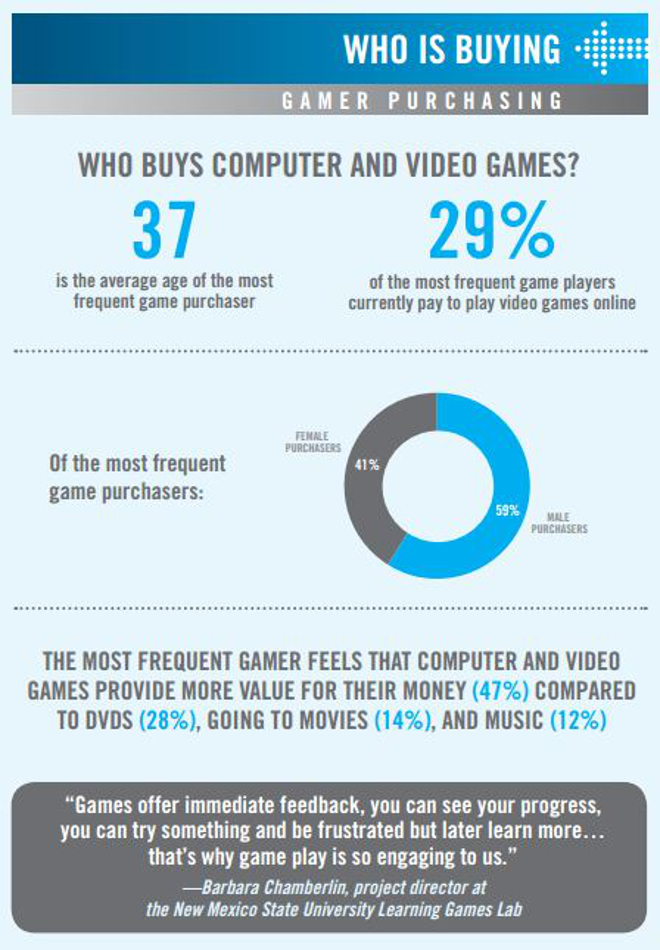Despite being decades old, games and computer entertainment in general never seems to fade away. In fact, if the latest developments are any indication, demand for complex interactive virtual worlds is on the rise, and we may soon find ourselves spending much of our time in simulated environments.
But let’s talk present day. To draw a clearer picture of the computer and video game industry as a whole, the Entertainment Software Association (ESA) conducted a study on more than 4,000 American households to determine things like who plays video games, who buys the hardware and the content, what types of games are played most often, how interacting with games affects our brains, etc.
The 2015 Essential Facts About the Computer and Video Game Industry was released by the Entertainment Software Association (ESA) this month. The actual research was done by Ipsos MediaCT for ESA, and there’s a great deal of data from NPD as well. Here are a few outstanding data points.

Photo by Andre Hunter on Unsplash
U.S. women are hardcore gamers
The last time anyone counted heads in the USA, the federal republic was home to 318.9 million individuals. According to the ESA report, nearly half of those (155 million) are active gamers. There are an average of two gamers in each game-playing household, and four out of five households own specialized gaming gear, such as a computer or a game console.
Of the surveyed households, 51% percent own a dedicated game console like the PlayStation 4 or the Xbox One. 42% of Americans play video games an average of three hours per week, which the ESA defines as “regularly.”
Contrary to what you might imagine, the average gamer is not a teenager but a full blown adult around the age of 35. The breakdown goes like this: 26% under 19 years, 30% are between 18 and 35, 17% are between 36 and 49, and as many as 27% are aged 50 or older. Gender-wise, 56% of the gamers are male and 44% are female.
Another interesting aspect, women who are 18 or older represent a much greater portion of the gamer population (33%) than boys 18 or younger (15%). Another chunk of data from the survey may even tell us why. According to the PDF report, 39% of the most frequent gamers play social games. Also, the most frequent female game player is 43 years of age, and the average male gamer is 35. Avid gamers have been playing for roughly 13 years now.
Who buys the games, what genres and platforms stand out
According to Barbara Chamberlin, project director at the New Mexico State University Learning Games Lab, “Games offer immediate feedback, you can see your progress, you can try something and be frustrated but later learn more… that’s why game play is so engaging to us.” That’s also why the most frequent gamer feels that such content is actually worth buying (47%), as opposed to music (12%) and movies (14%). Of the most frequent game buyers, 41% are wp,em amd 59% are men.
The top three game genres named by those surveyed are social (31%), action (30%), and puzzle/board/card/game shows (30%). The top three types of games that avid gamers enjoy on their wireless or mobile devices are social games (31%), puzzle/board/game show (14%), and action (5%).
By far the top device used for gaming is the PC (62%), followed by game consoles (56%), smartphones (35%), wireless devices (31%), and dedicated handheld systems like the PS Vita (21%). You’ll notice that these particular numbers make up more than a typical full-circle pie chart. That’s because no single platform is exclusively used for gaming, and gamers today get their fix on multiple devices.
Recent video game adopters admitted to spending considerably less time in front of the TV and / or going to the movies. More than half of all console owners use their device to also watch movies, and a third employ their gaming gear to keep tabs on their favorite TV shows. 27% also use it for music playback, and 20% watch live content and other stuff on their dedicated gaming machine.
Gaming makes you think like a designer
Among the many other interesting data points dished out by the ESA, this one clearly stands out. Dr James Paul Gee is cited as saying that gaming plays a crucial role in the way our brains work and develop over time. His research indicates that playing video games keeps your brain in check for society in the 21st century.
“Video games are complex systems composed of rules that interact. Gamers must think like a designer and form hypotheses about how the rules interact so they can accomplish goals and even bring about emergent results. Thinking like a designer in order to understand systems is a core 21st-century skill.”
And according to Ralph Baer, a pioneer of the home game console, had it not been for our constant demand for crisp visuals, “complex computer graphics would still be found only in the high-priced domains of the business and science world.”
Some raw numbers
With the help of NPD Group, the ESA was able to extract the best-selling computer game super genres by units sold, including strategy, sports, shooters, family entertainment, racing, role playing, and others. It also extracted the top 20 selling games of 2014, including a general breakdown for all the platforms, and a more concise breakdown representing only PC sales.
Curious to know which games took the crown? When all platforms are considered, Call of Duty: Advanced Warfare is the top selling game of 2014, tracked by Madden NFL 15 in second place, and multiplayer-sensation Destiny in third. When the PC gets singled out, The Sims 4 is the most popular purchase in 2014, followed by The Sims 3: Starter Pack, and Diablo III: Reaper of Souls.
Total consumer spend on games in 2014 amounted to $22.41 billion, of which $1.93 billion was lavished on accessories, $5.08 billion on machines that can run games, and $15.4 billion on content (games and DLC).
Also worth pointing out is that digital sales continue to chip away at the share of physical formats. 2014 marked the first time when digital game sales (52%) surpassed traditional physical media (48%). The full report – containing a bunch more interesting facts that I’ll let you discover on your own – can be found here: 2015 Essential Facts About the Computer and Video Game Industry.

Post A Reply